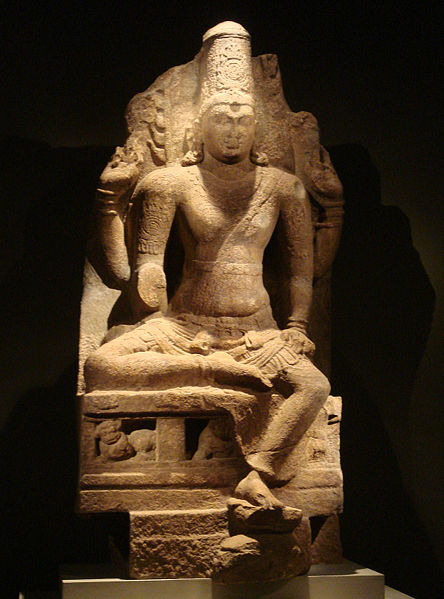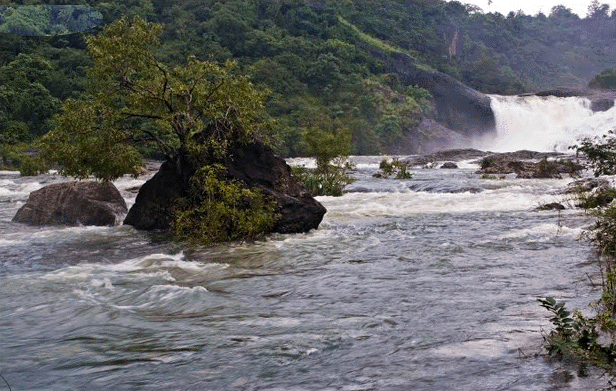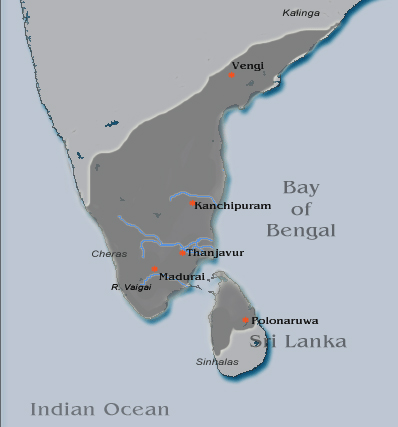
|
|
|
|
BY: SUN STAFF

Lord Visnu Feb 28, CANADA (SUN) — A serial exploration of the holy sites visited by Lord Caitanya. Pandya-desa
Today we resume our exploration of the places Lord Caitanya visited during his preaching sojourn in South India. In Madhya Lila 9 we read about the Lord's visit to Pandya-desa:
Madhya Lila 9 Summary "Then the Lord went to Setubandha and took His bath at Dhanus-tirtha. He also visited Ramesvara, where He collected some papers connected with Sitadevi, whose illusory form was kidnapped by Ravana. The Lord next visited the places known as Pandya-desa, Tamraparni, Naya-tripadi, Ciyadatala, Tila-kanci, Gajendra-moksana, Panagadi, Camtapura, Sri Vaikuntha, Malaya-parvata and Kanya-kumari." Later in Madhya 9, Srila Prabhupada provides further details on Pandya-desa: Madhya 9.218
SYNONYMS TRANSLATION PURPORT

Tamraparni River, Pandya-desa The Pandyan Dynasty began in the 2nd century B.C. in the south of India as an ancient Tamil state, one of the four Dravidian Tamil dynasties along with the Cholas, Cheras, and Pallavas. The Pandyas are mentioned in the Pillars of Ashoka (c. 273-232 B.C.). In his inscriptions, Asoka refers to the peoples of South India — the Cholas, Cheras, Pandyas and Satiyaputras — as being the recipients of his Buddhist preaching: "The conquest by Dharma has been won here, on the borders, and even six hundred yojanas (5,400–9,600 km) away, where the Greek king Antiochos rules, beyond there where the four kings named Ptolemy, Antigonos, Magas and Alexander rule, likewise in the south among the Cholas, the Pandyas, and as far as Tamraparni (Sri Lanka)." [1] In Caitanya-caritamrta Adi lila 1.19, and elsewhere in Srila Bhaktisiddhanta Saraswati Thakur's writings we find mention of the Pandya kingdom, primarily in reference to it being the birthplace of Sri Visnuswami, Acarya of the Rudra Sampradaya. Srila Bhaktisiddhanta describes why the priests at Jagannatha Puri are known as the Lord's 'pandya' servants, as noted in this excerpt from our Rudra Sampradaya section: "There were three Acaryas bearing the name of Visnuswami in the Rudra sampradaya. The first is called Adi Visnuswami, who is said to have been born about the third century B.C. in the Pandyan country. Visnuswami's father Devesvara was the royal priest and minister. Devatanu, as he was known before he took the sannyasa name of Visnuswami, was trained by his father in a vigorous theistic education, to fight Buddhism. The Pandyan king exerted all his influence to crush Buddhism in particular and other non-Vaisnava sects in general. King Pandyovijaya and his minister, Devesvara, went to Puri and recovered the Deities of Jagannatha, Balarama and Subhadra, which had been turned into the Buddhist Dharma by Buddha and Samgha by the Buddhists. King Padyovijaya and Devesvara removed the deities from the main temple to Sundaracala about two miles away by cart. This is said to be the origin of the Rathayatra of Jagannatha. Now the ceremony of conveying the Deities from the temple to the car is named Pahandi or Panduvijaya. The word Panda is applied to the priests of Jagannatha and is said to be derived from the "Pandya". The Deities were again brought back to the temple after Buddhism had been suppressed to some extent." Although we know that the Pandya region associated with Lord Caitanya's travels is in South India, not the north, Pandya-desa still covers a significant distance. As Srila Prabhupada explains, this Pandya-desa is known as Kerala and Cola, and as described in an earlier segment on the Tamraparni River, this reference to Kerala and Cola' means Kerala and Tamil Nadu. Many rulers in this area were referred to as 'Pandyas'.

Pandya-desa Region, mid-13th c. At the time Lord Caitanya was on tirtha-yatra in the south, this Pandya-desa is said to have corresponded to the Madura and Tinnevally districts, with its capital at Madura, also known as Daksina Mathura. [2] This southern Mathura is also mentioned among the places Lord Caitanya visited (Madhya 9.178 and 9.210). The rivers Kritamala (Vaigai) and Tamraparni flowed through Pandya-desa. The Pandus are mentioned as being the ruling race of Indraprastha in the Mahabharata, as well as in several Jatakas. Ptolemy (c. 150 A.D.) wrote about the country of the Pandoouoi, and there is no doubt that the Pandu were in northern India, as confirmed by Srila Bhaktisiddhanta Saraswati.
Katyayana's statements have connected the Pandyas with the Pandus based on the fact that the name of the Pandya capital (Madura) was identical with the famous city of Mathura in the Surasena country, which according to the epic was the seat of a family intimately associated by ties of friendship and marriage with the Pandus of Indraprastha.
The Sage Agasthya of Ramayana fame founded the first Tamil Sangam in South Mathura, and the southern Pandya kingdom of this period is mentioned in Ramayana. For example, King Dasaratha invited kings from different states, including Pandya-desa and Chola-desa for the coronation of Prince Rama.
During various periods of the Tamil Sangam, the Pandya kings had to move their capitals to new cities due to the rising oceans that engulfed their land. The Pandyas became established at Kapatapuram for this reason, and again at South Mathura (Madura).
The exact periods of Pandya history are a subject of much debate amongst historians. It's generally accepted that the last great Pandyas were in rule from the 12th to 14th centuries, and some argue that they were fully dispersed by the time the Madurai Sultanate was established, although that historical marker is argued as being anywhere from the 13th to 16th centuries. Nonetheless, it seems safe to say that at the time Lord Caitanya visited Pandya-desa, references to the place were considered in the context of the Late Pandya period.
| |
